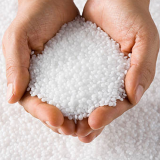Polyethylene Recycling Raw Material

Polyethylene is a widely used plastic that can be recycled to create raw material for various applications. The recycling process of polyethylene involves converting used or waste plastic into new products or materials. There are two main types of polyethylene: high-density polyethylene (HDPE) and low-density polyethylene (LDPE).
When polyethylene is recycled, it typically goes through the following steps:
-
Collection: Used polyethylene products, such as plastic bottles, containers, bags, or films, are collected through recycling programs or waste management systems. These items are sorted and separated from other types of waste.
-
Sorting and cleaning: The collected polyethylene items are sorted by type (HDPE or LDPE) and color. This step helps ensure that the recycled material is of consistent quality. The sorted polyethylene is then cleaned to remove any contaminants, such as labels, dirt, or residue.
-
Shredding and melting: The cleaned polyethylene is shredded into small pieces or flakes. These flakes are then melted at a controlled temperature to form a molten plastic.
-
Extrusion or pelletization: The molten polyethylene is either extruded into thin strands, which are then cooled and cut into pellets, or it is directly pelletized. Pelletization involves shaping the molten plastic into small, cylindrical pellets. Pelletization is a common method because it facilitates handling, storage, and transportation of the recycled material.
-
Reuse or manufacturing: The resulting polyethylene pellets can be used as a raw material for various applications. They can be mixed with virgin (new) polyethylene to create new plastic products, such as bottles, containers, pipes, plastic lumber, or films. The recycled polyethylene can also be used in the production of non-plastic products, such as textiles, fibers, or composite materials.
It's worth noting that the quality and properties of the recycled polyethylene may differ from those of virgin polyethylene. Recycled polyethylene may have slightly reduced mechanical strength and may contain some impurities, depending on the effectiveness of the recycling process. However, advancements in recycling technologies and sorting techniques aim to improve the quality and usability of recycled polyethylene.
Overall, recycling polyethylene helps reduce waste, conserve resources, and decrease the environmental impact associated with the production of new plastic materials.


